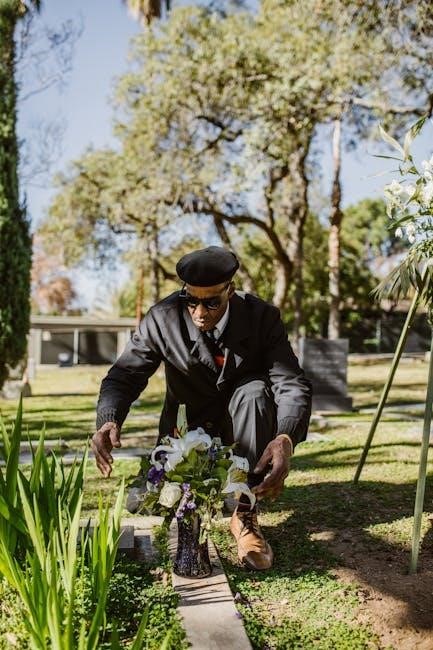Trauma is a profound emotional or psychological injury caused by distressing events. In Waking the Tiger, Peter A. Levine explores the body’s innate capacity to transform overwhelming experiences, offering hope for healing through somatic awareness and renegotiation of trauma.
Definition and Understanding of Trauma
Trauma is a profound disruption in an individual’s emotional, psychological, or physiological equilibrium, often resulting from overwhelming or distressing events. In Waking the Tiger, Peter A. Levine defines trauma as an incomplete biological response to threat, where the body’s instinctual defenses are not fully resolved. Unlike post-traumatic stress disorder (PTSD), trauma is not solely a mental health issue but a physiological one, rooted in the body’s “fight, flight, or freeze” responses. Levine emphasizes that trauma occurs when the body cannot process and release pent-up energy related to the stressful event, leading to long-term psychological and physical symptoms. This understanding shifts the focus from pathology to the body’s innate capacity for healing, offering a hopeful perspective on recovery and transformation.
The Effects of Trauma on the Body and Mind
Trauma profoundly impacts both the body and mind, disrupting emotional, psychological, and physiological balance. In Waking the Tiger, Peter A. Levine highlights how unresolved trauma leads to chronic stress, manifesting as physical tension, pain, and dysregulation of the nervous system. The body’s “fight, flight, or freeze” responses, when unprocessed, result in stored energy that can cause long-term health issues. Mentally, trauma often leads to anxiety, depression, and dissociation, as the mind struggles to integrate overwhelming experiences. Levine emphasizes that these effects are not merely psychological but deeply rooted in the body’s instinctual responses, underscoring the importance of addressing trauma at its physiological core to achieve lasting healing and restore equilibrium to both body and mind.
Traditional Approaches to Trauma Healing
Traditional approaches to trauma healing often focus on talk therapy, cognitive-behavioral techniques, and medication to manage symptoms. While these methods can provide relief, they may not address the physiological roots of trauma. In Waking the Tiger, Peter A. Levine critiques these methods for neglecting the body’s role in healing. He argues that conventional therapies may overlook the instinctual responses stored in the body, which are crucial for true recovery; Levine’s work introduces a shift from solely psychological interventions to a holistic approach that integrates the body’s natural healing capacities, offering a groundbreaking alternative to traditional methods.

Peter A. Levine and His Approach
Peter A. Levine, a pioneering therapist, developed Somatic Experiencing, a method emphasizing the body’s instinctual capacity to heal trauma. His work, detailed in Waking the Tiger, revolutionized trauma recovery by focusing on physiological responses and renegotiation of traumatic experiences.
Background and Contributions of Peter A. Levine
Peter A. Levine, a renowned therapist and trauma expert, has dedicated over three decades to studying post-traumatic stress and developing innovative healing methods. His groundbreaking work, particularly through Waking the Tiger, introduced the concept of Somatic Experiencing, a therapy that focuses on the body’s instinctual responses to trauma. Levine’s approach emphasizes the importance of understanding the physiological reactions to stress, which differ significantly between humans and other animals. His research, beginning in the 1970s, laid the foundation for a new understanding of trauma recovery, offering a hopeful vision of healing through the body’s innate capacity to transform overwhelming experiences. Levine’s contributions have profoundly influenced the field of trauma therapy, providing practical tools for both practitioners and individuals seeking recovery.
Somatic Experiencing (SE) is a groundbreaking therapy developed by Peter A. Levine, focusing on the body’s innate ability to process and release traumatic energy. This approach, detailed in Waking the Tiger, emphasizes the importance of reconnecting with the body’s instinctual responses, which are often disrupted during traumatic events. By gently engaging the nervous system and fostering awareness of physiological sensations, SE helps individuals renegotiate traumatic experiences without reliving them. Levine’s method highlights the body’s role as a healer, offering a powerful alternative to traditional talk therapy. This innovative approach has provided relief for countless individuals, empowering them to reclaim their resilience and restore balance in their lives.
The Core Principles of Levine’s Method
Peter A. Levine’s method, as outlined in Waking the Tiger, is rooted in the belief that the body possesses an innate capacity to heal from trauma. Central to his approach is the concept of “renegotiation,” where individuals recreate traumatic experiences in a controlled, empowering way. Levine emphasizes the importance of working with the body’s instinctual responses, rather than solely focusing on cognitive processing. His approach prioritizes gently guiding the nervous system to regulate physiological states, preventing overwhelm. Levine also stresses the role of the “felt sense,” a heightened awareness of bodily sensations, as a key tool for healing. By fostering resilience and reconnecting individuals with their natural responses, Levine’s method offers a powerful path to recovery, distinct from traditional therapeutic practices.

Key Concepts in “Waking the Tiger”

Peter A. Levine’s method emphasizes the body’s innate healing capacity, focusing on renegotiation, somatic awareness, and nervous system regulation to transform traumatic experiences.

The Concept of the “Felt Sense”

The “Felt Sense” is a key concept in Peter A. Levine’s approach to trauma healing, representing a non-conceptual, bodily awareness of sensations and emotions. Levine describes it as an internal sense that connects us to our physical and emotional states, allowing us to access and process unexpressed energies tied to traumatic experiences. This concept emphasizes the importance of tuning into the body’s wisdom rather than relying solely on cognitive understanding. By engaging with the Felt Sense, individuals can gently explore and release trauma without becoming overwhelmed. Levine’s method encourages clients to focus on subtle bodily shifts, fostering a deeper connection to their inner healing potential and enabling gradual renegotiation of traumatic memories. This approach avoids re-traumatization by working with small, manageable pieces of the traumatic experience. The Felt Sense serves as a bridge between the body and mind, facilitating a holistic path to recovery.
The Role of the Body in Healing Trauma
In Waking the Tiger, Peter A. Levine emphasizes the body’s central role in trauma healing. Levine argues that trauma is stored in the body as unresolved energy, which, if unaddressed, can lead to physical and emotional distress. He believes the body has an innate capacity to heal when given the opportunity to release this stored energy. Through somatic awareness, individuals can reconnect with their physiological responses, allowing the body to complete the natural “fight-or-flight” response that was interrupted during the traumatic event. This process enables the body to renegotiate the trauma, restoring balance and promoting healing. Levine’s approach empowers individuals to harness their body’s wisdom, demonstrating that the body is not just a victim of trauma but an active participant in recovery.
The Process of “Renegotiation” in Trauma Recovery
Renegotiation, a cornerstone of Peter A. Levine’s approach, involves guiding individuals to safely re-engage with traumatic experiences in a way that restores a sense of control and empowerment. This process allows the body to complete the interrupted “fight-or-flight” response, releasing pent-up energy and promoting healing. By revisiting the trauma in small, manageable doses, individuals can reinterpret the event without reliving the overwhelming emotions. Levine emphasizes that renegotiation is not about reliving the trauma but about creating a new narrative, where the body and mind recognize that the danger has passed. This method fosters resilience, helping individuals move from a state of helplessness to one of mastery, ultimately transforming traumatic memories into integrated, non-threatening experiences.

Practical Exercises and Techniques
This section introduces practical exercises like the Felt Sense Exercise and Self-Holding Techniques, empowering individuals to heal trauma through mindful body awareness and nervous system regulation.
The Felt Sense Exercise: A Step-by-Step Guide
The Felt Sense Exercise, developed by Peter A. Levine, helps individuals reconnect with their body’s innate healing capacity. Start by finding a comfortable position and focusing on internal sensations. Identify a specific area of tension or discomfort, then gently amplify the sensation without forcing it. Allow the body to naturally release stored energy through subtle movements or shifts. This process mimics the instinctual responses of animals, enabling the nervous system to renegotiate trauma. Regular practice fosters resilience and promotes emotional balance. The exercise is most effective when guided by a trained practitioner, ensuring a safe and transformative experience. By tuning into the “felt sense,” individuals can unlock their body’s wisdom and embark on a journey toward healing and wholeness.
Self-Holding Techniques for Nervous System Regulation
Self-holding techniques, as introduced by Peter A. Levine in Waking the Tiger, are gentle, non-invasive methods to regulate the nervous system. These exercises involve using physical touch to create a sense of safety and grounding. By placing hands on specific areas of the body, individuals can reassure their nervous system, reducing tension and promoting relaxation. Levine’s 2-Step Self-Holding Exercise, for example, guides individuals to hold their arms or legs gently, allowing the body to release stored energy and restore balance. These practices are designed to be done with minimal pressure, emphasizing comfort and awareness. Regular use of self-holding techniques can help individuals manage stress, enhance resilience, and foster emotional well-being by reconnecting with their body’s innate wisdom.
Practicing Mindfulness in Trauma Recovery
Mindfulness plays a crucial role in trauma recovery by helping individuals reconnect with their bodies and emotions. Peter A. Levine emphasizes the importance of being present with physical sensations, allowing them to arise and pass without judgment. This practice fosters awareness of the body’s innate wisdom, enabling individuals to gently release stored energy tied to traumatic experiences. Levine’s approach encourages gentle curiosity rather than force, creating a safe space for healing. Mindfulness complements somatic experiencing by promoting self-regulation and resilience. By focusing on the present moment, individuals can break free from the grip of trauma, fostering a sense of control and empowerment. This mindful awareness, as outlined in Waking the Tiger, is a powerful tool for transforming traumatic patterns and restoring balance to the nervous system.

Understanding Different Types of Trauma
Trauma can be acute, chronic, or complex, differing in duration and impact. Acute trauma results from single events, while chronic trauma involves prolonged exposure. Complex trauma arises from repeated, interpersonal harm, deeply affecting emotional and psychological well-being. Each type requires tailored approaches for healing, emphasizing the body’s role in recovery, as explored in Waking the Tiger.
Acute vs. Chronic Trauma
Acute trauma arises from single, overwhelming events, such as accidents or natural disasters, causing immediate distress. Chronic trauma, however, results from prolonged exposure to stressful or harmful situations, like abuse or neglect. While acute trauma may resolve with time, chronic trauma deeply embeds in the psyche, leading to long-term emotional and psychological damage. Both types disrupt the body’s natural response to stress, but their durations and impacts differ significantly. Levine’s work in Waking the Tiger highlights the body’s role in processing trauma, offering insights into how somatic experiences can aid recovery for both acute and chronic cases. Understanding these distinctions is crucial for effective healing strategies.
Complex Trauma and Its Unique Challenges
Complex trauma stems from prolonged, repetitive exposure to traumatic events, often involving interpersonal harm, such as ongoing abuse or neglect. Unlike acute trauma, which results from a single event, complex trauma deeply impacts emotional regulation, identity, and relationships. It can lead to fragmented memories, intense emotional dysregulation, and a distorted sense of self. Levine’s approach emphasizes the body’s role in storing and processing trauma, offering a pathway to healing through somatic awareness. In Waking the Tiger, he outlines how renegotiation of traumatic experiences can restore balance and resilience, addressing the intricate challenges of complex trauma with compassion and effectiveness. This method provides hope for those navigating the multifaceted effects of prolonged trauma.

Real-Life Applications and Case Studies
Levine’s work includes real-life case studies demonstrating the effectiveness of Somatic Experiencing in healing trauma. These examples highlight the transformative power of his approach in practical scenarios.
Case Studies from Levine’s Work
Peter A. Levine’s work is rich with real-life examples that illustrate the effectiveness of Somatic Experiencing. One notable case involves a boy who experienced severe trauma after a car accident. Through Levine’s gentle, non-invasive approach, the boy was able to reconnect with his body’s innate healing capacities. Levine guided him to focus on subtle physiological changes, such as tension in his muscles and shifts in his breathing, allowing the boy to gradually process the trauma without reliving the event. This case, among others, demonstrates how Levine’s method empowers individuals to renegotiate traumatic experiences, restoring balance and resilience. These examples highlight the practical application of Levine’s principles and their profound impact on trauma recovery.
Success Stories of Trauma Healing
Peter A. Levine’s work is filled with inspiring success stories that highlight the transformative power of Somatic Experiencing. One remarkable case involves a combat veteran who suffered from debilitating PTSD. Through Levine’s gentle guidance, the veteran learned to reconnect with his body’s sensations, gradually reducing his hyperarousal and flashbacks. Another success story features a woman who, after years of chronic pain from a childhood accident, found relief by processing the unresolved trauma embedded in her body. Levine’s approach has also helped countless individuals, including a young girl who overcame severe anxiety by renegotiating her traumatic experiences. These stories underscore the profound impact of Levine’s method, offering hope and evidence of its effectiveness in healing trauma.

The Impact of “Waking the Tiger”
Waking the Tiger has revolutionized trauma recovery, offering a life-changing guide to healing. Levine’s insights have inspired a global movement, transforming how we understand and address trauma, emphasizing the body’s innate capacity to heal and reclaim balance.
Reception and Reviews of the Book
Waking the Tiger has received widespread acclaim for its groundbreaking approach to trauma healing. Readers and professionals alike praise Levine’s accessible and compassionate writing style, which makes complex concepts understandable. The book is often described as life-changing, offering a hopeful vision of recovery. Levine’s argument that the body holds the key to healing resonates deeply, empowering individuals to reconnect with their physical sensations. Many reviewers highlight the practical exercises and real-life examples, which provide tangible tools for transformation. Since its publication in 1997, it has become a classic in the field of trauma recovery, inspiring countless individuals and therapists worldwide. Its enduring popularity reflects its profound impact on modern understanding of trauma and healing.
Comparison with Other Trauma Healing Methods
Compared to other approaches, Waking the Tiger stands out for its focus on somatic experiencing, emphasizing the body’s role in healing. Unlike cognitive therapies that target the mind, Levine’s method prioritizes physical sensations and instinctual responses. This contrasts with traditional talk therapy, which may not address the physiological roots of trauma. While methods like CBT and EMDR are widely recognized, Levine’s approach offers a unique, body-centered perspective. It aligns with mindfulness practices but diverges by focusing on reengaging the body’s innate capacity to process trauma. This holistic view sets it apart, making it a complementary or alternative approach for those seeking to integrate physical and emotional healing. Levine’s work has thus expanded the landscape of trauma therapy, offering new possibilities for recovery.
Cultural and Scientific Impact of Levine’s Work
Peter A. Levine’s work, particularly Waking the Tiger, has had a profound cultural and scientific impact, reshaping understanding of trauma and recovery. His introduction of Somatic Experiencing (SE) revolutionized the field, offering a body-centered approach that complements traditional therapies. Levine’s theories have influenced global trauma treatment, bridging psychology and physiology. Culturally, his work has fostered empathy and awareness, reducing stigma around trauma. Scientifically, SE has gained recognition for its evidence-based effectiveness, validated through clinical practice and research. Levine’s methods are now used worldwide by psychotherapists, bodyworkers, and medical professionals, highlighting the universal relevance of his insights. His work continues to inspire interdisciplinary approaches to trauma healing, leaving a lasting legacy in both scientific and cultural domains.
Peter A. Levine’s groundbreaking work offers empowerment through somatic awareness. For deeper exploration, his book Waking the Tiger and resources on Somatic Experiencing are highly recommended.
Final Thoughts on Healing Trauma
Healing trauma is a transformative journey that requires patience, self-awareness, and compassion. Peter A. Levine’s approach emphasizes the body’s innate wisdom as a powerful healer. By tuning into the felt sense and engaging in somatic practices, individuals can renegotiate traumatic experiences and restore balance to their nervous systems. Levine’s work reminds us that trauma is not a life sentence but an opportunity for growth and resilience. The key lies in reconnecting with our instinctual capacities and fostering a deeper understanding of our bodily responses. Through this mindful process, true healing becomes possible, allowing individuals to reclaim their lives and live fully; Levine’s insights offer hope and practical tools for anyone seeking to overcome trauma and embrace a path toward wholeness.
Resources for Further Exploration
For those seeking deeper understanding, Waking the Tiger: Healing Trauma by Peter A. Levine is a seminal text. Published in 1997, it explores somatic experiencing and offers practical tools for trauma recovery. Additional resources include Levine’s other works, such as Healing Trauma and In an Unspoken Voice, which expand on his methodologies. Online courses and workshops on somatic experiencing are available through Levine’s official website, providing hands-on training. The book has been widely praised for its combination of scientific insight and accessible techniques, making it a valuable resource for both professionals and individuals on a healing journey. Levine’s work continues to inspire new approaches to trauma recovery, emphasizing the body’s role in healing.



